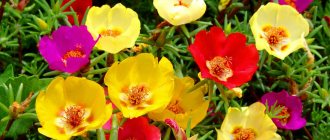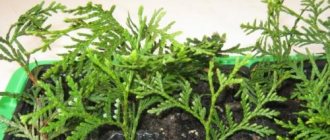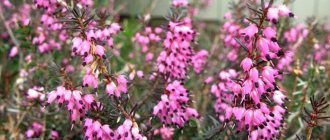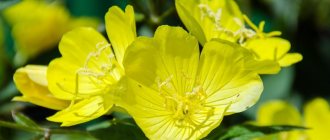Lisianthus (eustoma) in nature and in design
Eustoma has many names and is also known among flower growers under the name of Russell's lisianthus, Irish, Japanese rose, and Texas bell. This is a representative of herbaceous plants, a biennial. Nowadays the name Eustoma is more often used, which translated from Greek means beautiful lips. Lisianthus (translated as “bitter flower”) is the name of the same genus according to the botanical classification, now obsolete. Eustoma is a native of the southern regions of the United States, northern regions of Mexico, and is found in the Caribbean islands. In its homeland, the flower is called: Texas bell, tulip gentian, and sometimes just gentian.
Described back in the eighteenth century, large-flowered eustoma (Eustoma Grandiflorum) and Russell's eustoma (Eustoma Russilianus), as a result of the active work of breeders, gave rise to various varieties.
This botanical genus includes 3 species:
- Small eustoma, small gentian, western gentian, blue marsh eustoma (Eustoma exaltatum);
- Eustoma grandiflorum;
- Lisianthus, Eustoma Roussel, or Russell (Eustoma russellianum).
In the wild, eustoma reaches a height of 60 cm, its flowers are of various shades of blue . The stems are powerful, the leaves are elongated and colored dark green, with an unusual bluish tint. The wild plant prefers well-lit, warm places with fertile, light soil. Propagated by seeds, under normal conditions it is a biennial.
The varieties bred by breeding scientists delight the eye with flowers of white, purple, yellow, red, and apricot colors. Bicolored and bordered eustoma flowers look unusually impressive. The appearance of lisianthus buds is unusually similar to unblown roses, and many varieties do not lose this similarity during flowering, but only look more delicate. Elongated leaves in combination with widely branching stems, on which up to thirty delicate inflorescences ripen in turn, create a unique image of lisianthus, a simply royal appearance. Breeders have developed varieties with simple and double petals, giving the flowers additional splendor. The subtle beauty of the plant has not gone unnoticed by designers and florists; eustoma is used in the preparation of wedding bouquets, for decorating banquet halls, and for special events.
Photo gallery: eustoma in design
In the decoration of special events, lisianthus flowers look elegant and elegant.
Eustoma in the composition of a wedding bouquet
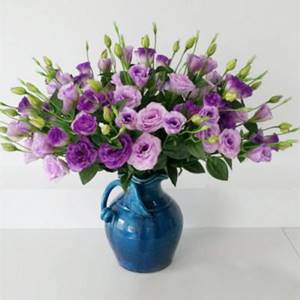
A bouquet of lisianthus will decorate any interior

Eustoma is often used in the groom's boutonnieres.
Where is the best place to grow a flower?
You can grow eustoma both at home, on balconies, loggias, and in garden plots. You need to focus on the climatic conditions of the region. The flower feels good as a balcony decoration. When planting seedlings in open ground, the plant blooms until September, and when frost approaches, it can be moved indoors, where the lisianthus will delight the owners for a long time.
Lisianthus annual and perennial
In its homeland, lisianthus is a biennial plant in nature, but when grown in open ground it is used as an annual plant, since its delicate root system cannot withstand winter cold. This is not surprising if we remember the origin of the flower - there is no frost in its homeland. Although scientists have developed varieties that are resistant to low temperatures, the geography of year-round cultivation of eustoma in the garden in our country is limited (in winter the air temperature should not be lower than +10°C).
At home, eustoma can be cultivated for more than one year, but according to reviews from amateur flower growers, even under favorable circumstances, the plant degenerates after two years and does not produce the expected flowering. Therefore, lisianthus are often grown as indoor flowers for one year and discarded after flowering.

There are many varieties of eustoma seeds on sale for every taste.
The seeds of this flower are almost always sold labeled “annual”. If you want to extend the life of a plant planted in open ground, when frost approaches, you need to dig it up entirely and store it at home. With proper care, there is a chance that in the spring the eustoma will begin to grow and will delight you with flowers for another season.
Technique for sowing eustoma seedlings
- Pour the prepared soil into the seed containers and compact it a little.
- Wet the soil well with a sprayer, but do not flood it.
- Distribute the granules over the surface, pressing only slightly, but not deepening - the seeds need light to germinate. It is convenient to spread the seeds using a toothpick with a moistened tip.
- Apply a drop of water to each seed using a pipette or syringe.
- Cover the containers with transparent film (glass) to create a greenhouse effect.
- Keep containers with crops in the light at a temperature of 20–24°C during the day and not lower than 15°C at night.
Lisianthus series and varieties: descriptions with photos
Selection work with lisianthus has not stopped to this day. New series are constantly appearing, within which a wide range of varieties of various types and colors is presented.
Varietal series are divided into two large groups:
- tall - reaching a height of up to a meter or even more, planted in open ground for cutting;
- low-growing - compact varieties, perfect for growing at home on a windowsill.
The difference exists not only in the size of adult plants, but also in the shades of the petals; within each group there are plants with double and simple flowers. Most of the seed material comes from the USA and Japan. So far, breeders have not been able to breed climbing eustoma. Under the guise of a climbing lisianthus, the gardener will, at best, get a climbing or park rose.
Tall
ABC F1 is a series of double annual lisianthus. The height of the stems reaches 75–100 cm, the inflorescences are large, 5–6 cm in diameter. Series varieties: Blue border, Blue haze, Blue blush.
Kyoto F1 - this series represents a selection of tall (up to 90 cm) varieties with simple, non-double flowers, early flowering. Representatives of this series: Picot Wine Red, Picot Pink, Picot Blue, White Kyoto.
Photo gallery: eustoma series ABC and Kyoto

The Blue Border variety looks unusual and attractive

The Blue Haze variety is named for the smooth transition of colors in color.
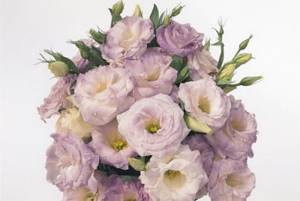
The Blue Blush variety is distinguished by a gentle transition from light to rich tones
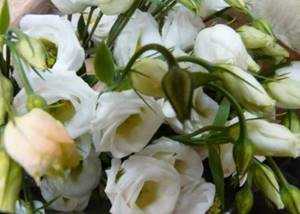
Kyoto White is the most common in the series
Echo F1 is another series of tall eustoma, bred by Japanese scientists, with stems up to 70 cm long, simple flowers, classified as annuals. Bouquets of plants on tall, strong stems look great as cut flowers.
Photo gallery: Echo series for open ground

Flowers of the Echo Yellow variety are painted in delicate shades of lemon
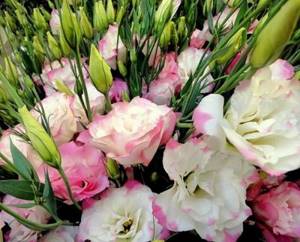
Piccoti pink collected in lush inflorescences
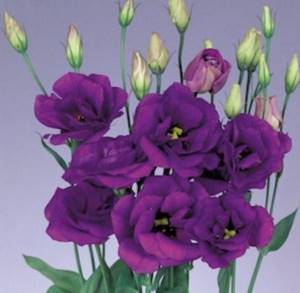
Rich blue color of the petals of Echo Blue
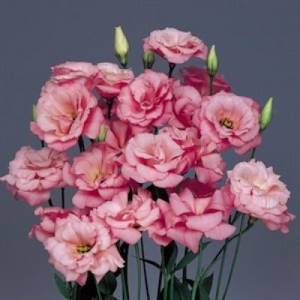
Bouquet of eustoma Echo Pink
Flamenco F1 is a series of tall eustoma (up to 70 cm), with large, up to 7 cm in diameter, simple (non-double) flowers. An early-flowering variety, annual, flowering begins 2 weeks earlier than others. The most common varieties are Yellow, Lime, and Pink.
Arena F1 is a series of lisianthus with stem heights of 80–100 cm. Double flowers up to 7 cm in size are painted in a variety of shades; manufacturers classify the variety as annual. Lush red flowers are collected in luxurious inflorescences.
Photo gallery: annual plants of the Flamenco series, Arena

The bright red color of lisianthus Arena Red will not leave you indifferent
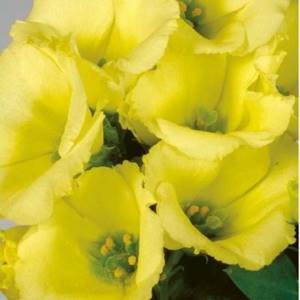
Representative of tall varieties of lisianthus Flamenco Yellow

Delicate inflorescences of the Flamenco Lime variety
The Piccolo F1 series is represented by a line of tall varieties of lisianthus, annual, with stems 70 cm long, and simple large flowers.
Japanese breeders presented the Wonderose series - tall plants (up to 70 cm), annuals, forming lush caps of simple large flowers. The most famous varieties are Light Brown, Ash.
Photo gallery: eustoma of the Piccolo and Wonderose series

A bouquet of two-color eustoma Piccolo looks unusual
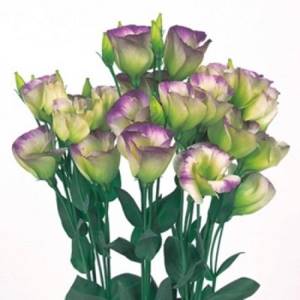
Purple-blue-edged petals of Lisianthus Piccolo variety Northern Lights
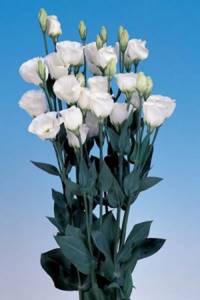
Snow-white flowers of eustoma Piccolo White attract the eye

The eustoma variety Wonderose Light Brown has petals painted in light shades of brown.
The delicate border of eustoma petals especially attracts attention.
Universal (for garden and windows) varieties
There are eustoma seeds on sale with stem heights up to 50 cm. Such plants are planted both at home and on the site.
Twinkies - a series with flowers 50 cm tall, spirally arranged simple flowers. There are many varieties, the most common are Pink, Blue-violet, Yellow.
Cinderella F1 is a series of eustoma with stem heights up to 50 cm, annual, with simple flowers of various colors.
Photo gallery: series for home and garden

The Twinkie variety Blue-violet will attract the attention of guests

Flowers of the Twinkie Pink variety collected in a bouquet

The delicate pink color of the petals highlights the Cinderella Pink variety
Low varieties - can be grown in pots
Compact varieties do well at home. Manufacturers have developed many series with small-sized plants. Here are some of them.
Eustoma Mermeid (Little Mermaid) F1 is a series of low-growing lisianthus. The height of the stems is about 15 cm, the flowers are simple 6 cm in diameter, perennial. Varieties: White, Lilac-pink, Soft pink, Blue, Mixture.
Photo gallery: Mermaid's long-running series (The Little Mermaid)

Potted form of Lisianthus Mermaid White

Eustoma Mermaid Soft pink in containers for growing in an apartment
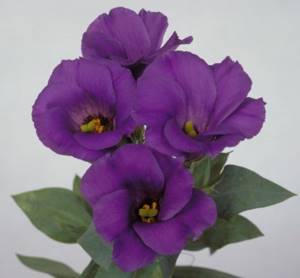
Bouquet of Lisiathnus Mermaid Blue
A very compact series, ideal for home breeding - Sapphire F1. A perennial potted plant, 13–20 cm high, flower size up to 5 cm, both double and simple varieties have been bred.
Photo gallery: blooming Sapphire series
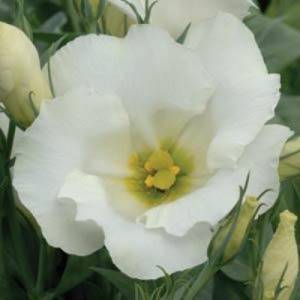
Eustoma flower Sapphire White with simple large petals

Sapphire Blue is perfect for growing in pots

Lisianthus Sapphire Pink in a pot - a wonderful home decoration
The Carmen F1 series is another representative of low-growing potted crops. Plant height is 20–25 cm, annual, flowers reach a size of 4–6 cm. Varieties: White-blue (with rim), Lilac, Rose, Ivory, Blue.
Florida F1 is a series of compact annual lisianthus 20–25 cm high, with double and simple flowers up to 10 cm in diameter. The most famous varieties: White, Sky Blue, Pink.
Photo gallery: Carmen and Florida room series

Low-growing variety of eustoma for the home Carmen Belaya
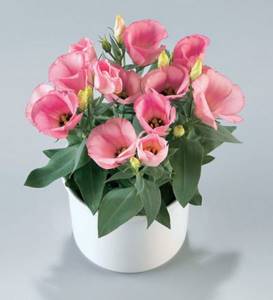
Carmen Pink looks elegant in a flowerpot
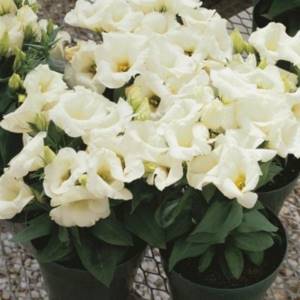
Lisianthus variety Florida White grows well in pots

Lush Florida Sky Blue bush will decorate the interior
Choose plants you like and let them delight you with beautiful flowering for a long time.
Popular varieties of perennial eustoma
The result of selection is a variety of Irish rose varieties. Among the tall ones, the following are popular:
- Heidi – red wine color;
- Mariachi lime – yellow-green;
- Flamenco – blue, yellow;
- Twinkies – white, pink, purple.
Planting gentian at home for seedlings and caring for it
Tall varieties are perfect for growing on site. During the period of active flowering, they will decorate the garden with luxurious flowers, which, when cut, will last at home for up to two weeks. Preparations for planting in open ground begin long before spring with the cultivation of seedlings.
When to sow
It will not be possible to plant seeds directly into the ground on the site, especially before winter - eustoma does not tolerate temperatures below +10°C. The period from planting to flowering takes 22–26 weeks, so seeds should be planted for seedlings in December–February.
Can it be propagated by cuttings or roots?
Propagation by cuttings is possible only in theory; in practice they do not take root. The same thing happens when dividing the rhizome - the fragile roots of lisianthus react painfully to any damage. That is why dividing the bush can lead to the death of the entire plant.
As for propagation by bulbs, this is basically impossible, since lisianthus is a herbaceous plant and does not form bulbs.
If you are offered to buy lisianthus bulbs, walk away. At best, the seller is deluding himself, at worst, he is trying to deceive you.
Growing from seeds
Reproduction by seeds is perhaps the only really effective way to propagate eustoma. Planting seed material is sold in a wide range, although more recently it was available only to special farms involved in floriculture. The seeds of the plant are extremely small, one gram contains from fifteen to twenty thousand, so they go on sale in the form of pills. The shell serves as auxiliary nutrients that help in the development of the plant at the initial stage.

Due to their very small size, lisianthus seeds are sold in pelleted form.
How to till the soil and plant seeds
The soil for planting should be light, a commercially available mixture for Saintpaulia works well. Another option is to plant seeds in peat tablets. They are convenient because in the future you can dispense with transshipment into larger containers without damaging the sensitive roots of small lisianthus. How to prepare the soil yourself:
- Mix two parts peat moss with one part garden soil and half part sand.
- The soil must be sterilized, as the slightest infection can quickly kill the seedlings. To do this, the soil is spilled with boiling water and a strong (dark pink) solution of potassium permanganate.
- After the earth has cooled, the seeds are planted - laid out on the surface of the soil and lightly pressed down.
Sterilization is also required for containers in which seedlings are planted. Peat tablets are also treated with boiling water and potassium permanganate, after they have swollen to the desired size and cooled, they begin to plant seeds.

The seeds are laid out on the ground and pressed lightly
Planting process:
- The seeds are laid out on the surface of the prepared soil and lightly pressed down.
- After planting, you need to moisten the soil; it is convenient to use a spray bottle for this.
- The nutrient composition covering the seeds hardens after drying, which creates difficulties for weak shoots to germinate. To avoid such problems, after moistening the dragee, you can gently crush it with a toothpick, destroying the shell.
- The planting is covered with film or glass, you can use a container with a transparent lid, and placed in a well-lit place.

Planted seeds are sprayed with water
Caring for eustoma seedlings
Eustoma seedlings are very demanding of light; plantings should be placed on well-lit window sills. Seeds planted in winter need additional artificial lighting due to the short daylight hours. You can use a phytolamp (sold in stores that specialize in selling garden supplies); if you don’t have one, a regular fluorescent lamp will do. Seedlings should be under artificial light for up to 12–15 hours a day until approximately the end of March.
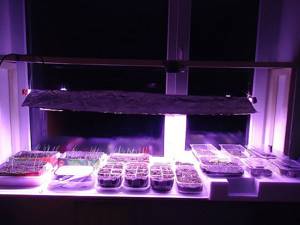
Seedlings should be kept under lighting at night in winter.
When germinating seeds, you need to ensure a favorable temperature regime . During the day, seedlings should warm up to 22–25°C, at night - no lower than 18°C. At first, you won’t have to moisten the germinating seeds very often, since in closed containers there will be enough evaporated moisture. If the soil dries out, carefully spray it with water from a spray bottle. Be sure to provide ventilation for the germinated seedlings by removing the lid from the container or removing the film for 5–10 minutes.
The first shoots appear approximately two weeks after planting the seeds. Germination of lisianthus is considered good if 40–50% of the planted seeds have germinated. After the first sprouts appear, watering should be carried out only in the morning, so that the stem and leaves have time to dry by the evening. This will reduce the risk of seedlings becoming infected with root rot. Approximately 5–6 days after germination, seedlings need to begin hardening off. On the first day, air baths are performed for 10 minutes, then the same amount is added every day. After reaching three hours, the film cover (container lid) can be removed.
Recent Entries
5 working ways to use tar in the garden 7 indoor plants that help you get married even in adulthood Indoor plants that can bloom in trouble

When picking, plants are placed in separate containers
After two pairs of true leaves appear, 6–8 weeks after germination, the seedlings are planted in separate pots. The sprouts will be very small, but this is the normal appearance of a plant at this age. When picking, you need to carefully pick up the seedling with a toothpick along with a lump of soil and replant the baby separately. You should not delay picking; the rapidly growing root system is easy to damage. The soil for transplanted sprouts is taken the same as when planting. It does not need to be sterilized; it is enough to treat it with fungicides (antifungal drugs). Fundazol diluted in water at the rate of 1 gram per 1 liter of water is suitable.
After a month, the grown seedlings need to be transferred to larger containers . You need to act carefully, trying not to damage the roots.
- Place expanded clay drainage at the bottom of the container (layer thickness - 3 cm).
- Then soil is poured - about 4 cm (you need to focus on the size of the container and the plant itself).
- The sprouts are removed along with the soil and very carefully moved to a new container.
- Spread the soil along the walls of the container, lightly compacting it, being careful not to leave the root collar exposed.
- After transshipment, water.
In the future, it is important not to overwater or dry out the plants. Lisianthus should be watered when the top layer of soil dries out with warm water that has settled. It is strictly forbidden to spray growing eustomas with water - this leads to diseases of the leaves and stems.

The seedlings will grow in these pots before being transplanted into the garden.
If the seedlings grow slowly
Flower growers who breed eustoma note that in the first months, lisianthus grows very slowly. This is due to the expansion of the root system, after which the above-ground part begins to grow. Therefore, if it seems that the seedlings have stopped and are not growing in size, this is normal; after a couple of months, active growth of the plant itself will begin.
For more abundant flowering, you can pinch lisianthus at the stage of appearance of 5–6 pairs of leaves. This procedure will make the plant bushier.
Feeding seedlings
Seedlings can be treated with biogrowth stimulator Epin at the rate of 4 drops per 100 ml of water. The plants are sprayed after picking, timing them so that the leaves dry out by evening. After transplantation, the plant begins to be fed weekly; Agricola for flowering plants is suitable for this. It is better to use the liquid form of the fertilizer, diluting it with water according to the instructions. Many gardeners recommend slightly lower concentrations than those indicated by the manufacturers.
Video: growing lisianthus from seeds at home
Planting and care in open ground
Eustoma has grown stronger, the weather outside has settled, and the threat of frost has passed. You can transfer seedlings to the site. There are also rules here.
Choosing and preparing a place
A tropical flower, of course, needs a lot of light. Therefore, the site should be in the sun, preferably also on a small hill. This is necessary in order to minimize the risk of moisture stagnation during periods of prolonged rain. Eustoma is very capricious in this regard - even short-term stagnation can affect the flower until it dies.
Eustoma is a decorative flower, so it is either planted separately or with those plants and flowers that will not distract or shade this highlight of the garden. The area needs to be cleared of plant residues, poured with boiling water and manganese, dug up and loosened. First you must test the soil for acidity, the optimal level is 6.5-7 pH. If the soil is acidic, then during digging, add a glass of lime to one meter square of soil.
The holes are dug at a distance of 35-50 cm from each other, so that the root and the earthen ball are located freely. If you planted seedlings in peat tablets, then transfer them directly into the ground.
Important! During transplantation, you need to transfer the entire earthen ball with roots, without cleaning it and without injuring it as much as possible. This is a very risky moment and an important condition in the matter of growing and further caring for eustoma in the garden.
Planting and care
At the bottom of the hole you need to lay a layer of drainage, then a layer of humus, spill it and plant the seedlings. Here again you can use Fundazol to prevent illnesses, according to the instructions. The flowers are not fed for about three weeks; they adapt to the new place. You just need to water it with settled water as it dries and remove the weeds.
Eustomas bloom in July; in the budding phase, you need to add fertilizer, which will contain more phosphorus and potassium and less nitrogen. Preparations such as Plantafol Budding when the inflorescences bloom, Kemira or Kemira Lux have a good effect on flowers. They make flowering more luxuriant and longer. But remember that you need to make the fertilizing concentration a little weaker than the recommended dose on the package.
Eustomas delight with their flowers even in autumn. The last feeding will be after flowering; it may be a mineral complex. In the summer, you can use additional organic matter - mullein infusion - 1/10 or chicken manure - 1/20 at the root. When the buds are completely dry, seed pods will form on them. They are collected on a warm day, when there has been no rain for 1-2 weeks, dried and stored until spring. Then the process is repeated, the seeds germinate quite well.
Advice! It is better to cut off all those flowers that have already withered; this will prolong flowering and it will be more abundant.
Wintering eustoma
After flowering has finished and you have collected the seeds, you need to take care of the plant. So, how to preserve eustoma in winter? If you want your flowers to continue to grow and delight you, then in the fall you need to dig them up and plant them in a pot. Watering is first reduced to a minimum, all branches are cut off, as new shoots will grow in the spring. Then you plant the eustoma in a pot with drainage holes, a layer of expanded clay and a soil mixture, but the flower must overwinter at a cool temperature. Watering is carried out once every 10-14 days. In the spring you can plant the Irish rose again in the ground.
Transplanting seedlings into the garden
Lisianthus can be planted on the site as soon as night temperatures reach at least 18°C. The area should be well lit, preferably not in direct sunlight, with good air movement, but without strong piercing winds. The soil needs to be light, loose, not waterlogged.
- Shallow (you need to focus on the size of the eustoma) planting holes are dug in the ground at a distance of 20–30 cm.
- Mineral fertilizer is added to the planting holes; nitrophoska is suitable. Eustoma requires neutral soil, so in areas with high acidity you need to add a little wood ash to the planting holes.
- The soil in the hole is mixed with fertilizer and the eustoma is planted, trying not to bury it lower than it was in the pot.
- After planting, it is necessary to water the plant without wetting the leaves.
- Mulch the ground around the seedling with peat.
The soil for eustoma in the garden is mulched with peat
In the future, the process of caring for lisianthus comes down to the need for timely watering; the dried top layer of soil will be the guideline. Loosening is necessary, this is necessary for good aeration of the root system. Varieties planted on the site usually reach a height of about 1 meter, so support will be needed. Bamboo is suitable for this purpose; a support with hooks for orchids will do a good job. During the entire period that eustoma is in the garden until autumn, you need to apply complex flower fertilizers weekly in a slightly lower concentration than recommended.
Care during flowering
Depending on the variety and timing of seed planting, lisianthus flowering begins in mid-July and continues until September. An extremely fragile plant at the beginning of its life develops into a powerful bush, crowned with a whole bouquet of flowers. During flowering in dry weather, watering is increased, not forgetting to mulch the soil around the flowers.
However, in a rainy summer, the eustoma will be extremely uncomfortable; flowers and buds can rot from getting wet, and the risk of fungal infections increases. Rotting flowers and leaves must be removed, and the plant must be treated with Fitosporin or similar fungicides for preventative purposes.
Blooming flowers can be cut, at home they will stand in water for about two weeks, and at the place of the cut the shoot will grow again and produce new buds. The flowering of lisianthus is long and abundant; one shoot can produce up to 30 buds, blooming alternately.
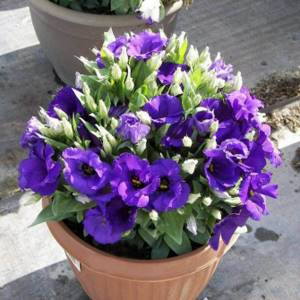
Proper care of eustoma ensures long flowering
What to do with perennials in the fall
Eustoma blooms for a long time, until the first frost. As cold weather approaches, there are two options:
- Cut off the flowers and unopened buds; they will delight you with their appearance for another two weeks, and dig up the bush and dispose of it.
- Bring the bush home for storage.
If you want to grow a biennial plant, you need to winterize the plant at home:
- Carefully dig up the lisianthus, without damaging the roots, along with the earthen lump.
- Plant in a suitable size pot and place at home.
- At room temperatures, the plant will bloom, after which watering should be reduced.
- Trim the stems, leaving three internodes.
- Determine for winter storage at a temperature of 10–150 degrees Celsius.
Is it possible to collect the seeds yourself?
You can collect the seeds of the plant, but there is one subtlety. They are mainly sold in series marked F1. This letter indicates that the seeds belong to heterotic hybrids. Such plants are either sterile, or the seeds they produce do not carry parental characteristics in the second generation. That is, if you are lucky enough to collect seeds and germinate them, the result may be unpleasantly surprising - something completely different from the previous generation will grow. The best solution would be to buy new seeds for planting next year.
Care during wintering
- A plant prepared for wintering with cut stems should be placed in a dimly lit place at a temperature of +10°C.
- Reduce watering to once or twice a month, you can stop completely, and do not fertilize.
- When new shoots appear on the lisianthus, you will need to resume watering, increase the temperature and place it in a lighted place.
Gardeners, planning to grow eustoma as a biennial plant, use a more convenient way to transport the plant for wintering without transplanting. The flower is initially brought to the site in a pot, dug in, and with the onset of cold weather it is brought into the house with the same pot. This reduces the risk of damage to the roots, and the plant tolerates the dormant period more comfortably. You cannot leave a plant on a plot in winter in Russia - this will definitely destroy it.

When planted in the ground immediately in a spacious pot, it is easy to dig up the plant for the winter
Perennial
In the wild, lisianthus grows for two years. This is exactly how much it is recommended to grow in summer cottages in central Russia.

But due to complex care, professionals can handle the task. It is possible to achieve the desired flowering in a greenhouse.

How to care for eustoma in an apartment
Low-growing varieties of lisianthus are ideal for growing indoors. Seed manufacturers offer a wide selection to suit every taste. Usually you can see marks on the seed packets indicating the height of the plant. Compact series will fit perfectly on the windowsill and will delight you with large, bright flowers.
Growing indoors
Planting seeds and the main stages of caring for germinating seedlings for indoor propagation are no different from growing seedlings intended for open ground. Everything has been discussed above. The only difference is that after transplanting the grown seedlings, they remain on the windowsill until flowering begins.
Eustoma feels comfortable in the temperature conditions of the apartment. The lighting should be bright, but without direct sunlight.
Table: seasonal conditions for keeping lisianthus at home
| Season | Temperature | Humidity | Watering | Top dressing | Illumination |
| Summer | +22оС…+24оС | Do not wet the leaves and stems by spraying. You can place trays of water next to the eustoma. | Sufficient, as the soil dries to a depth of 2 cm. Pour out excess water from the pan immediately. | Every week or every two weeks, apply fertilizers for flowering plants (Agricola - according to the instructions, the dosage can be taken a little less than indicated). | Bright light without direct rays hitting the plant. |
| Winter | +10о…+15оС | Do not moisturize. | Reduce. | Do not carry out. | Shaded place. |
It is not difficult to maintain lisianthus at home. The temperature in the apartment is quite suitable for the flower’s comfortable existence. It is better to determine the place for it on window sills facing west or east. Eustoma is a lover of light, but direct contact with the burning rays of the sun can damage leaves and flowers.
You can determine when to transplant the eustoma into a larger pot by the roots that begin to make their way through the drain holes of the pot. This indicates that the plant has become crowded. A container with a volume of 2–2.5 liters is enough for 3 plants, which will develop and actively grow throughout the growing season until they enter a dormant state.
Humid air is beneficial for the plant, but it is important to remember that leaves and flowers cannot be sprayed, as this can lead to rot. The best option would be to place a container filled with water next to the flower pot.
If you decide to leave the lisianthus for the next year, after flowering the stems are cut off, leaving three internodes, and watering is reduced.
Problems and their solutions
In any growing option, be it an apartment or a garden plot, lisianthus is not immune to the danger of diseases and pests. Seedling diseases are easier to prevent because they are difficult, sometimes impossible, to treat. To prevent the fungus from infecting the seedlings, be sure to sterilize the soil for planting and all equipment.
Experienced gardeners do not mention pulling out seedlings, but to prevent this scourge, it is necessary to supplement the plantings with lamps in the winter season. To protect young seedlings from lodging, you need to protect them from drafts and regularly inspect them for diseases and pests.
Table: typical pests and diseases of eustoma
| Disease/ Pest | Signs of the disease | Control measures | Prevention |
| Aphid | Leaves and buds curl and fall off. Pests are visible to the naked eye. Transparent drops remain on the plant. |
|
|
| Whitefly | Visually distinguishable white insects on flowers. Deformed, yellowed leaves, the appearance of light or yellowish spots on them. | ||
| Powdery mildew | White coating on the leaves, spreading to the stems. Young leaves grow curled, old leaves turn yellow and wither. |
|
|
| Gray rot | The appearance of brown spots or gray fluffy coating on the stems and leaves. Leaves and flower stalks rot and subsequently die. |
|
|
| Fusarium wilt | The leaves wither, turn yellow, curl, and die. The stem at the root collar darkens. |
|
|
